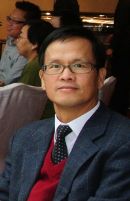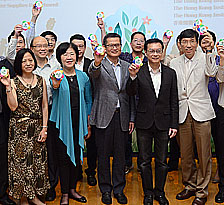The Food Wise Hong Kong Campaign, a territory-wide food waste reduction campaign, was officially launched today (May 18) to encourage the entire community, from individuals and households to commercial and industrial sectors, to avoid and reduce food waste generation in Hong Kong.
More than 250 representatives from various sectors including hotels and restaurants, residential estates and shopping malls, government departments, schools and universities, green groups, women's organisations and food recipient organisations participated in the launch ceremony at Olympian City 2 today to show their support for the Campaign.
The Food Wise Hong Kong Campaign, one of the signature events under the theme of "Fresh Hong Kong" of the "Hong Kong: Our Home" Campaign, aims to promote public awareness of the food waste problem in Hong Kong and instill behavioural changes in various sectors of the community with a view to reducing food waste generation.
Officiating at today's ceremony, the Chief Secretary for Administration, Mrs Carrie Lam, said food waste reduction is one of the key initiatives in the environmental policy of the current-term Government, calling on every member of the public to work together to tackle the problem and put into practice "123" tips in daily life. The three tips are: first, to avoid leftovers in every meal; second, to make good use of food trimmings for the second dish; and third, to think before you buy to avoid wastage. In addition, the commercial and industrial sectors can reduce food waste and operating cost through good planning and management. She was delighted to witness the overwhelming response from different sectors and thanked members of the public for their support to the Campaign.
Addressing the ceremony, the Secretary for the Environment, Mr Wong Kam-sing, said about 40 per cent of municipal solid waste disposed of at landfills every day is food waste. Of which, about 70 per cent of food waste come from the domestic sector and the rest from the commercial and industrial sectors.
Sharing his thoughts on food waste reduction, Mr Wong said we have to share the responsibilities and change our habits, treasure the resources on the Earth and donate excessive food to the needy. Meanwhile, he said commercial and industrial sectors and households could also adopt green cooking ideas.
The Food Wise Hong Kong Steering Committee (FWHKSC) for the Campaign, which is chaired by the Secretary for the Environment, has built up a Food Wise Charter and has invited various organisations to be Food Wise partners. Up to now, over 150 organisations, including various trades, non-governmental organisations and government departments, have signed the Charter to show their support for the Campaign and to commit to reducing food waste. Representatives of more than 90 organisations participated in the launch ceremony to pledge their concerted efforts to practising food waste reduction.
Today's ceremony also featured the first appearance of a "Big Waster", a character symbolising food wastage, and to remind members of the public not to waste food and to change wasteful habits.
Also officiating at today's ceremony were the Permanent Secretary for the Environment/Director of Environmental Protection, Ms Anissa Wong; the Chairman of Subcommittee of the General Publicity and Education of the FWHKSC, Mr Poon Kai-tik; and the Chairman of the Subcommittee of Food Waste Reduction Good Practices in Institutions and Commercial and Industrial Establishments of the FWHKSC, Mr Daryl Ng.
The FWHKSC was set up in December last year to formulate and oversee the implementation strategy and programme of the Food Wise Hong Kong Campaign.
Under the Campaign, a host of publicity activities and educational programmes, including exhibitions and competitions, will be organised. In addition, the recruitment of individual Food Wise Ambassadors from the community and organisations has commenced. Training will be provided to help ambassadors to spread the message and practical tips about food waste reduction across the community.
Tool kits and practice guides are also being drawn up with trades and organisations to assist relevant sectors in adopting food waste management in their daily operations and individual households in practising food waste reduction in daily life. Up to now, four sets of food waste reduction good practice guides and tips have been developed for the hotel sector, the food and beverage sector, the shopping mall sector and the residential sector respectively.
In addition, support will be rendered to non-governmental organisations to conduct community events and workshops to help disseminate the food waste reduction message and practices. Other highlights of the Campaign include the promotion of food donation to charitable organisations from establishments with surplus food.
Details of the Food Wise Hong Kong Campaign are available on the dedicated website:
www.foodwisehk.gov.hk/en/

























